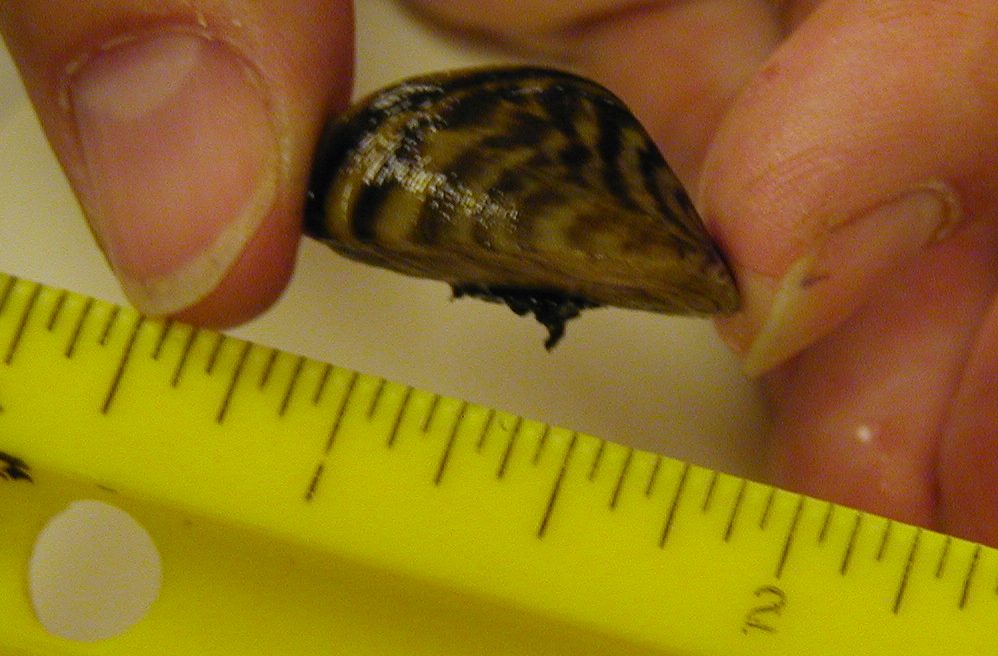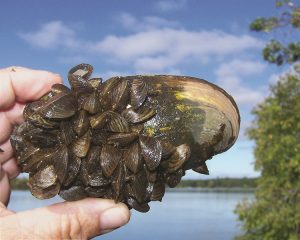Recent updates from the McKenzie Lakes Area Zebra Mussel Management Team: the 2018 Progress & Planning Report and the Rapid Response Plan for newly detected populations.
From the Fish Lake Property Owners Association: Ways to Zap Zebra Mussels
In October 2016, an alert property owner found two zebra mussels on the southern shore of Big McKenzie Lake which straddles the Burnett-Washburn County line. The Wisconsin DNR’s follow-up inspections found one more at the same location and six at the northeast corner of the lake. Also in October, a single zebra mussel was found in Polk County’s Deer Lake.
 These are the first zebra mussels found in the 12 northwestern counties of Wisconsin, but they have been spreading into the eastern U.S. and Canada since they arrived in the Great Lakes in the ballast water of ships in 1988. Click here to see a visual depiction of their rapid progression.
These are the first zebra mussels found in the 12 northwestern counties of Wisconsin, but they have been spreading into the eastern U.S. and Canada since they arrived in the Great Lakes in the ballast water of ships in 1988. Click here to see a visual depiction of their rapid progression.
Zebra mussels have now been found in 259 Wisconsin waterbodies.
Click here to see a current list.
Zebra mussels are small invasive mussels that attach to hard surfaces in lakes and rivers. They can be ¼” to 2” long; most are about the size of a thumbnail. They have alternating dark and light stripes. The light stripes range in color from white to yellow. Zebra mussel larvae are known as veligers and are essentially invisible to the naked eye.
There is no known selective treatment for zebra mussels at this time. The negative impacts of zebra mussels are both environmental and economic. Zebra mussels compete for food with the immature or smaller prey species of fish. This can lead to a collapse or severe impairment of the fishery food chain from the bottom up. In addition, zebra mussels encrust boats, motors, docks and water intake systems. Their shells are very sharp and cut the feet of humans who are swimming or walk along the beaches barefoot. Click here to see a presentation by Dick Sternberg that provides more information about zebra mussels and their impacts.
The likelihood that a particular waterbody will become infested depends on whether there is enough calcium in the water for the zebra mussels’ shells. Click here to view a list of Washburn County waters that are modeled to be “Suitable” or “Borderline Suitable” to sustain a zebra mussel population. Note that this list includes information to access an interactive map showing which lakes in Wisconsin are at-risk. As with most models, there are exceptions. Lakes connected to suitable lakes, for example, have a higher chance of establishing zebra mussel populations regardless of their suitability.

Zebra mussels on a native mussel – photo courtesy of MN DNR
The best way to prevent new infestations of zebra mussels is to decontaminate boats, jet skis, trailers and other equipment that has been in an infested lake. This can be done as the boat leaves the infested lake or at the landing before it enters another lake or any time in between. It is very important that the decontamination process includes emptying all water that could be carrying veligers, such as water in live wells, bait wells, and motor cooling systems. (Veligers can easily be spread in water but are more vulnerable than are the mature mussels.) Decontamination of the exterior surfaces can be accomplished by spraying the equipment with very hot water or with a bleach solution. Click here to read the Wisconsin DNR’s recommended decontamination practices.
Public agencies, lake associations and individual volunteers are taking action to stop the mussels from spreading from the McKenzie Lakes and to determine whether other lakes in our region may also be infested. Washburn and Burnett Counties have sent a letter urging local lake service providers to help prevent the spread. Click here to view the letter.
You can help too! Here are some important steps you should take now:
- Be sure to INSPECT your own boat for zebra mussels and other plants and animals. REMOVE all plants and DRAIN all water. NEVER MOVE plants, critters or water to another lake.
- As you put your equipment back into the water this spring especially, look for zebra mussels on the ground. During the summer, check your boat, dock, lift and raft periodically to look for attached zebra mussels. If you see any suspicious mussels or shells, take a picture of the mussel, bag it and write down the date and location (GPS if possible). Then contact Kris Larsen (the WDNR) at 715- 635-4072 or Lisa Burns (Washburn County Land & Water) at 715-468-4654.
- If you have a service provider putting your boats, lifts, docks, etc. into the water, ask whether they have used their equipment in the McKenzie Lakes. If they have, require them to decontaminate that equipment as part of your service.
- Make sure that your lake association or individuals are monitoring your landing(s) and scrutinizing incoming equipment for zebra mussels. Maximize the hours that trained monitors are at your landing(s) and make sure they know about zebra mussels. If possible, obtain decontamination equipment for your landing. If you don’t have an AIS grant this year, be sure to apply for one for next year. WCLRA can help.
- If you don’t have a lake association, consider forming one. Again, WCLRA can help.
- Learn all that you can about zebra mussels. Information is available on the Wisconsin DNR website and on many other websites. Check the Events list on this website for workshops and public meetings.
We will continue to update this website with more information about zebra mussels and efforts to prevent their spread. If you have specific questions, please contact Lisa Burns (Washburn County Land & Water) at 715-468-4654, Cathie Erickson (WCLRA) at 715-865-4406 or Fred Blake (WLCRA) at 715-469-3228.







